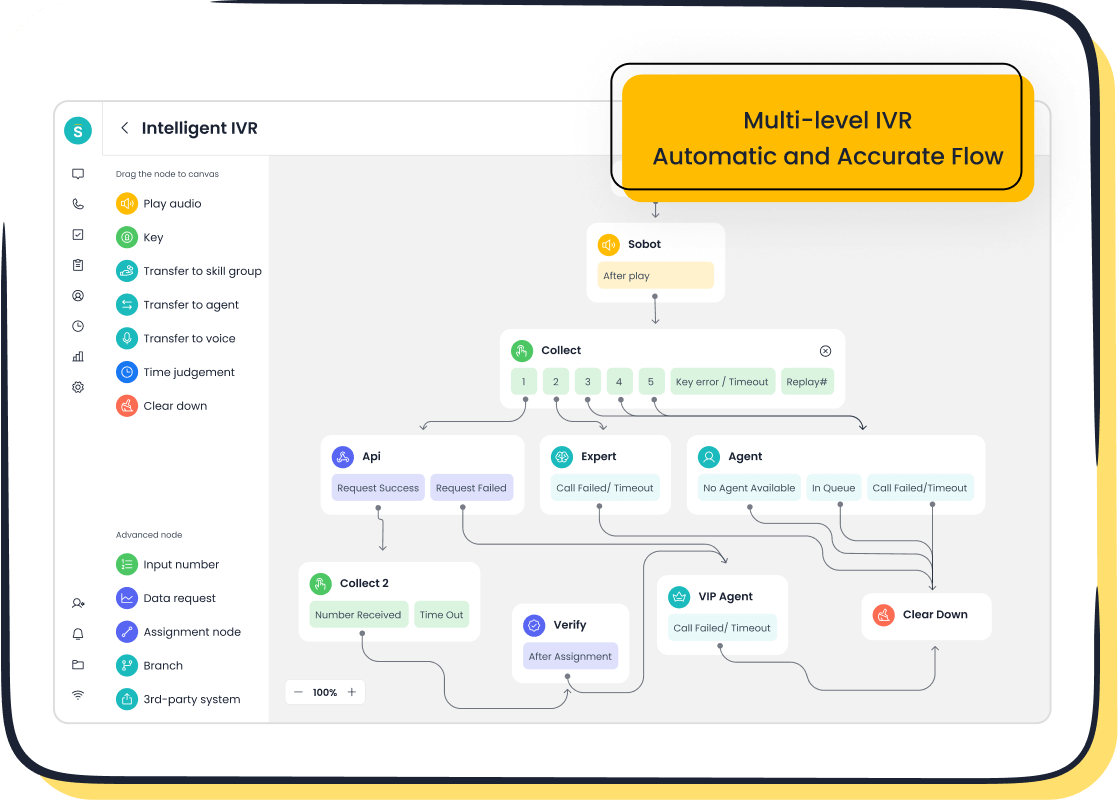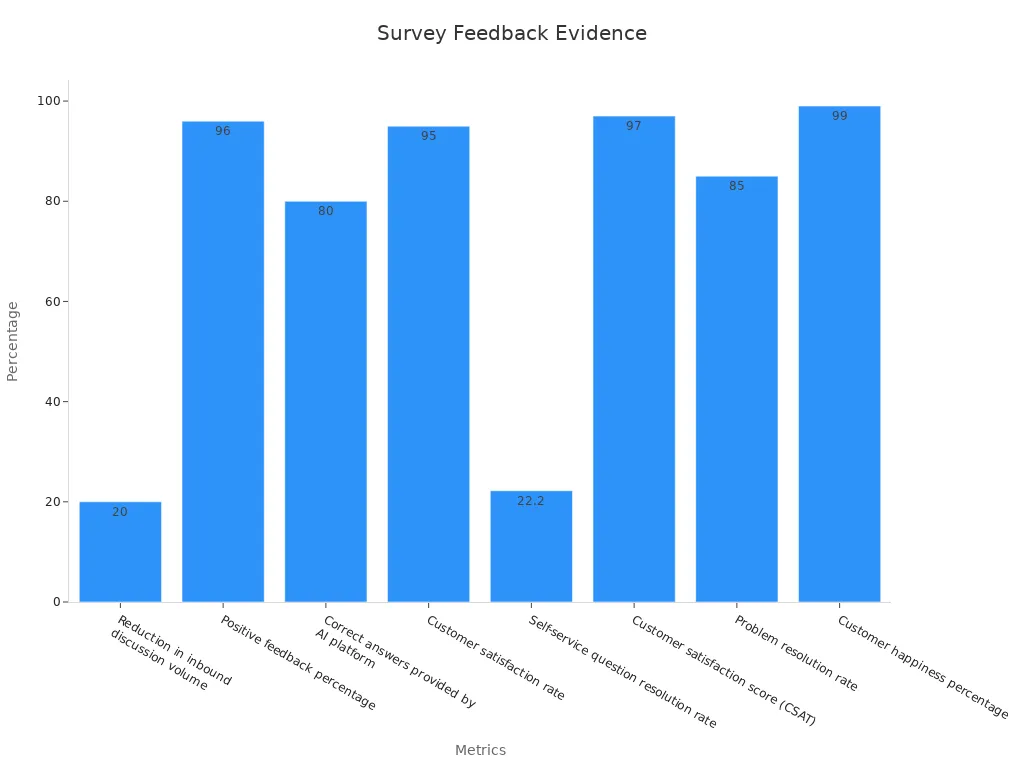Improve CSAT Survey Responses in Easy Steps

Improving customer satisfaction isn’t just a nice-to-have; it’s essential for keeping your customers loyal and happy. Did you know that 91% of customers won’t return after a bad experience? Or that 33% will consider switching to a competitor after just one misstep? These numbers show how critical it is to understand your customers better through effective customer satisfaction surveys, such as a csat survey example. By gathering feedback, you can pinpoint what’s working, what’s not, and make changes that drive better customer experiences. Plus, companies with higher satisfaction ratings, like those using Sobot, often see a 12% boost in stock prices—a win-win for everyone. Ready to dive in?
Simplify the Survey for Better Customer Feedback

Keep It Short and Focused
When it comes to customer surveys, less is more. Long surveys can feel like a chore, especially when customers are busy. Studies show that surveys taking over 12 minutes often lose participants' interest, leading to lower response rates. To keep your audience engaged, aim for surveys that take five minutes or less to complete.
Shorter surveys not only encourage participation but also improve the quality of responses. When customers don’t feel overwhelmed, they’re more likely to provide thoughtful feedback. This is especially true if there’s no incentive for completing the survey. By focusing on brevity, you make it easier for customers to share their experiences without feeling burdened.
Use Clear and Simple Language
Clarity is key when crafting customer survey questions. Using simple words ensures that your questions are easy to understand, even for those with varying levels of literacy. Research highlights that surveys written at a middle school reading level improve comprehension and reduce confusion.
| Benefit of Simple Language | Key Takeaway |
|---|---|
| Improves comprehension | Customers understand questions better. |
| Reduces reading difficulty | Makes surveys accessible to everyone. |
| Maintains accuracy | Simple wording doesn’t compromise results. |
Avoid jargon or overly technical terms. Instead, use straightforward language that resonates with your audience. This approach not only enhances understanding but also ensures you get accurate and reliable feedback.
Prioritize Key Questions Over Quantity
Every question in your survey should serve a purpose. Instead of overwhelming customers with a long list, focus on the ones that matter most. For example, combining ranking questions with open-ended ones can give you both measurable data and deeper insights into customer motivations.
By prioritizing key questions, you reduce the cognitive load on your audience. This makes it easier for them to complete the survey while providing meaningful responses. Plus, well-structured surveys minimize errors and improve data quality, helping you make informed decisions.
Remember, it’s not about asking more questions—it’s about asking the right ones. When you focus on what truly matters, you’ll gain valuable feedback that drives better customer satisfaction.
Optimize Timing to Maximize Customer Surveys
Send Surveys Immediately After Interaction
Timing is everything when it comes to customer surveys. Sending surveys right after a customer interaction ensures their experience is fresh in their mind. This approach captures genuine emotions and detailed feedback, leading to better insights.
| Evidence Description | Impact on Response Quality |
|---|---|
| Surveys presented immediately after interactions capture fresher sentiment. | Higher engagement rates and improved response quality. |
| Significant drop-off in response rates between immediate and delayed requests. | Emphasizes the importance of timing in feedback collection. |
| Immediate requests during customer experiences generate stronger engagement. | Leads to more accurate and relevant feedback. |
When you act quickly, customers are more likely to respond. They feel their opinions matter, and you get feedback that’s both timely and relevant. This strategy not only boosts response rates but also helps you identify areas for improvement in the customer journey.
Avoid Busy Times for Customers
Ever wondered why some surveys get ignored? Timing could be the culprit. Avoid sending surveys during busy periods when customers are less likely to engage. Studies show that Mondays and Tuesdays are ideal for survey distribution, while Fridays and weekends see the lowest response rates.
| Study Focus | Key Findings |
|---|---|
| Customer Feedback Surveys | Higher response rates on Mondays compared to other days; Fridays had the lowest response rates. |
| Email Marketing | Tuesdays had the highest open and click-through rates; weekends had the lowest engagement. |
| Survey Timing | 10:00 am is optimal for survey distribution; responses decrease significantly after 6:00 pm. |
By choosing the right time, you make it easier for customers to participate. For example, sending surveys mid-morning, around 10:00 am, aligns with their natural workflow. This thoughtful timing increases participation and ensures you collect meaningful responses.
Experiment with Different Times to Find What Works Best
Not every customer follows the same routine. Experimenting with different survey times can help you discover the optimal window for your audience. Flexibility in timing allows you to adapt to varying schedules and preferences, ensuring you reach more customers effectively.
For instance, some industries find success with evening surveys, while others benefit from early morning outreach. Testing different times lets you refine your strategies and maximize engagement. This approach ensures your surveys align with customer habits, leading to better feedback and actionable insights.
Timing isn’t just about sending surveys—it’s about understanding your customers’ rhythms. By experimenting and analyzing results, you can create a survey process that fits seamlessly into their day, improving satisfaction and boosting responses.
Personalize the Experience to Enhance Customer Satisfaction
Address Customers by Name
Using a customer’s name in your survey makes the experience feel personal. It shows you value them as individuals, not just numbers. When you address customers by name, they’re more likely to engage with your survey. This simple touch builds trust and encourages honest feedback.
For example, instead of starting with “Dear Customer,” try “Hi [Name], we’d love to hear about your recent experience!” Personalized greetings make surveys feel less robotic and more human. They set the tone for meaningful responses and improve customer satisfaction.
Tailor Questions Based on Customer Interactions
Generic surveys often miss the mark. Tailoring customer survey questions to match specific interactions creates a more relevant experience. If a customer recently purchased a product, ask about their buying process. If they contacted support, focus on the resolution.
Tailored questions show you’re paying attention to their journey. They also make it easier for customers to provide detailed feedback. For instance, instead of asking, “How satisfied are you?” try “How satisfied were you with the support you received today?” This approach leads to actionable insights and helps you identify areas for improvement.
Make the Survey Relevant to Their Experience
Relevance is key to keeping customers engaged. A survey that aligns with their recent experience feels purposeful. Avoid asking unrelated questions that might confuse or frustrate them. Instead, focus on what matters most to their interaction.
For example, if a customer visited your website, ask about its usability. If they made a purchase, inquire about the checkout process. Relevant surveys not only boost responses but also provide feedback you can use to enhance the customer experience.
Tip: Use tools like Sobot’s Voice/Call Center to gather data and create surveys that match customer interactions seamlessly.
Personalization isn’t just a strategy—it’s a way to show customers you care. When you make surveys personal and relevant, you’ll see better engagement, more thoughtful responses, and higher satisfaction scores.
Offer Incentives to Encourage Participation

Provide Discounts or Coupons
Discounts and coupons are powerful motivators for survey participation. They give customers an immediate reason to engage while fostering loyalty and encouraging future purchases. Imagine receiving a coupon for 10% off your next order just for sharing your thoughts—it’s hard to resist, right?
These incentives work especially well for loyal customers who already trust your brand. They feel appreciated and are more likely to provide thoughtful feedback. However, it’s important to tailor these offers to your audience. For some, discounts might feel like marketing tactics rather than genuine rewards. To avoid this, make the incentive relevant to their experience. For example, offer a discount on a product they recently purchased or browsed.
Use Loyalty Points or Rewards
Loyalty points and rewards are another effective way to encourage survey responses. Customers love earning points that bring them closer to perks like free products or exclusive benefits. By tying surveys to your loyalty program, you create a win-win situation—customers get rewarded, and you gain valuable feedback.
Studies show that small cash incentives, like $2-$5, can boost survey participation by up to 20%. Similarly, loyalty rewards tailored to your audience can increase engagement and completion rates. For instance, offering bonus points for completing a survey not only drives responses but also strengthens customer retention. This strategy works particularly well for industries like retail and gaming, where loyalty programs are already popular.
Highlight the Benefit of Participation
Sometimes, customers need a little nudge to see the value of completing a survey. Highlighting how their feedback will improve their experience can make all the difference. For example, let them know their input helps refine products, enhance services, or resolve common issues.
You can also share examples of past improvements based on customer feedback. This builds trust and shows you genuinely care about their opinions. When customers see the impact of their responses, they’re more likely to participate. Combine this with a clear call-to-action, like “Help us make your next visit even better!” to inspire engagement.
Tip: Prepaid incentives, such as cash rewards or discounts, are particularly effective. They create a sense of reciprocity, encouraging customers to complete the survey as a way of giving back.
Offering incentives isn’t just about boosting survey responses—it’s about showing customers you value their time and feedback. When done right, these strategies can improve customer satisfaction, strengthen relationships, and drive better insights for your business.
Use Multiple Channels for Broader Reach
Expanding your survey distribution across multiple channels is one of the smartest strategies to increase customer engagement and gather diverse feedback. Different customers prefer different communication methods, so using a mix of channels ensures you reach a broader audience and boost response rates.
Send Surveys via Email
Email remains a reliable and effective way to distribute customer surveys. It allows you to reach a large audience while providing enough space to include detailed questions. Plus, email surveys are easy to track and analyze.
For example, if you have a customer list of 100,000 emails and a response rate of 25%, you can send out 67 surveys every three months to meet your target sample size. This method works well for businesses aiming to collect comprehensive feedback over time.
| Population Size | Sample Size (95% @ 5%) |
|---|---|
| 500 | 217 |
| 1,000 | 278 |
| 5,000 | 357 |
| 10,000 | 370 |
| 50,000 | 381 |
| 100,000 | 383 |
Email surveys also allow you to personalize your outreach. Addressing customers by name and tailoring questions to their recent interactions can make the experience more engaging and relevant.
Utilize SMS for Quick Responses
If you’re looking for faster responses, SMS surveys are a game-changer. They boast response rates 5-10 times higher than email surveys, with 31% of customers replying in under six minutes. That’s incredible for gathering real-time feedback!
SMS surveys work because they’re short, direct, and easy to complete. Most text messages are opened within three minutes, making this channel perfect for capturing immediate customer reactions. Whether you’re asking about a recent purchase or a support interaction, SMS ensures you get timely and actionable insights.
Leverage In-App Notifications for Engaged Users
For businesses with mobile apps, in-app notifications are a fantastic way to reach engaged users. These surveys feel natural because they’re integrated into the customer’s experience. For instance, you can ask for feedback right after a user completes a purchase or interacts with your app’s features.
Combining in-app surveys with other methods like email and SMS can dramatically increase your reach. This multi-channel approach ensures you connect with customers wherever they are, whether they’re browsing your app, checking their inbox, or reading a text message.
Tip: Using tools like Sobot’s omnichannel solutions makes it easy to manage surveys across multiple platforms. You can streamline your process and ensure consistent customer satisfaction strategies.
By leveraging multiple channels, you not only broaden your reach but also improve the quality of your customer feedback. This approach helps you understand your audience better, refine your questions, and ultimately enhance customer satisfaction.
Communicate the Value of Customer Feedback
Explain How Feedback Will Be Used
When customers share their feedback, they want to know it’s making a difference. You can build trust by explaining how their responses will be used to improve their experience. For example, let them know their insights help refine products, enhance services, and resolve common issues. This transparency shows you value their input and are committed to making meaningful changes.
You could say something like, “Your feedback helps us identify areas where we can improve and create better experiences for you.” This simple explanation encourages engagement and makes customers feel heard. When they understand the impact of their feedback, they’re more likely to participate in future surveys.
Share Examples of Past Improvements Based on Feedback
Sharing real-world examples of how customer feedback has driven improvements can inspire confidence and encourage participation. For instance, Matalan used survey responses to identify bugs in their checkout process. Fixing these issues led to a 1.23% increase in conversion rates and a 400% return on investment within nine months.
Here’s how feedback has statistically improved satisfaction levels:
| Evidence Description | Statistic |
|---|---|
| CSAT improvements post-purchase correlate with increased retention | 40% boost in 12-month retention |
| A 10% improvement in CSAT can reduce churn | Up to 12% reduction in churn |
| CSAT scores explain variance in retention rates | Up to 30% of variance explained |
These examples show how listening to customers can lead to measurable success. Sharing such stories demonstrates your commitment to using feedback effectively and motivates customers to share their thoughts.
Thank Customers for Their Time and Input
A simple “thank you” goes a long way in showing appreciation. When customers take the time to complete a survey, acknowledge their effort. You can say, “Thank you for sharing your thoughts. Your feedback helps us improve and deliver better experiences.”
Adding a personal touch, like mentioning how their input contributes to specific improvements, makes your gratitude feel genuine. This small gesture strengthens customer engagement and leaves them with a positive impression of your brand.
Tip: Consider sending a follow-up message after the survey to thank customers again and share how their feedback is being implemented. This reinforces their importance and builds loyalty.
By communicating the value of customer feedback, you create a cycle of trust and engagement. Customers feel their voices matter, which boosts satisfaction and encourages them to stay connected with your brand.
Test and Iterate for Continuous Improvement
Conduct A/B Testing on Survey Formats
A/B testing is a powerful way to refine your survey formats and uncover what works best for your audience. By comparing two versions of a survey, you can identify which design, wording, or layout resonates more with your customers. For example, an online bookstore tested two versions of a product page. The version with a green, larger "Buy" button saw a 10% increase in clicks compared to the blue button. This insight helped them make informed decisions based on actual customer behavior.
Small changes, like tweaking the color of a button or rephrasing questions, can lead to big improvements in customer feedback.
Here’s why A/B testing is worth your time:
- It provides a statistically rigorous framework for evaluating survey designs.
- Iterative changes validated by data lead to better outcomes.
- Comparative testing methods help you identify the best-performing elements in your surveys.
Start by testing different question formats, such as multiple-choice versus open-ended questions. You’ll gain actionable insights that improve response rates and satisfaction.
Analyze Response Data to Identify Trends
Your survey responses hold valuable clues about customer behavior and preferences. Analyzing this data helps you spot trends and patterns that can guide your decisions. For instance, statistical methods like correlation analysis and segmentation analysis reveal relationships between variables and uncover insights about different customer groups.
| Statistical Method | Description |
|---|---|
| Correlation Analysis | Identifies relationships between variables to find patterns or associations. |
| Regression Analysis | Evaluates the impact of independent variables on dependent variables and predicts outcomes. |
| Segmentation Analysis | Segments data based on demographics or behaviors to uncover trends within different groups. |
| Hypothesis Testing | Formulates hypotheses about relationships in data and validates findings through statistical tests. |
By interpreting customer feedback data, you can make data-driven decisions that improve your surveys and enhance customer satisfaction. For example, seasonal trends in responses might suggest adjusting your survey timing or questions to better align with customer needs.
Continuously Refine the Survey Process
Improvement doesn’t stop after one round of testing. Continuous refinement ensures your surveys stay relevant and effective. The Plan-Do-Study-Act (PDSA) cycle is a great framework for this. It involves planning changes, implementing them, studying the results, and acting on the findings.
| Metric | Before PDSA | After PDSA | Improvement |
|---|---|---|---|
| Overall Survey Responses | 57% | 84% | +27% |
| On-time Response Rate | Minimal | Minimal | N/A |
This iterative approach helps you adapt to changing customer expectations and improve response rates over time. Keep experimenting with new formats, analyzing feedback, and tweaking your process. You’ll create surveys that not only engage your customers but also provide meaningful insights for your business.

Leverage Sobot's Voice/Call Center for Enhanced Customer Experience
Use Intelligent IVR to Gather Feedback Efficiently
Sobot’s Intelligent IVR system makes collecting feedback a breeze. It’s designed to streamline the process, ensuring you get timely and accurate responses from your customers. With features like customizable greetings and real-time deployment, you can create surveys that feel personal and engaging.
IVR systems offer several benefits:
- They’re cost-effective, helping you allocate resources efficiently.
- They scale effortlessly, allowing you to gather feedback from thousands of customers at once.
- They provide real-time feedback, ensuring you can act quickly on insights.
- They’re accessible, even for customers without internet access.
These advantages make IVR a powerful tool for improving operational efficiency. For example, Sobot’s IVR ensures uniformity in survey questions, leading to consistent data collection. Plus, customers can participate outside regular business hours, boosting response rates.
| Benefit | Description |
|---|---|
| Cost-effectiveness | Efficient resource allocation for feedback collection. |
| Scalability | Thousands of customers can participate simultaneously. |
| Timely feedback | Real-time responses improve responsiveness. |
| Accessibility | Internet-free participation ensures broader reach. |
| Convenience | Surveys conducted anytime increase participation. |
Monitor and Analyze Call Data for Insights
Sobot’s Voice/Call Center doesn’t just collect feedback—it helps you turn it into actionable insights. With advanced monitoring and analytics tools, you can dive deep into call data to understand customer behavior and satisfaction levels.
Imagine reducing inbound discussion volume by 20% while maintaining a customer satisfaction score of 97%. That’s the power of Sobot’s analytics. You can track metrics like problem resolution rates and self-service success to pinpoint areas for improvement.
| Metric | Value |
|---|---|
| Reduction in inbound discussion volume | 20% |
| Positive feedback percentage | 96% + |
| Correct answers provided by AI platform | 80% |
| Customer satisfaction rate | 95% |
| Self-service question resolution rate | 22.2% |
| Customer satisfaction score (CSAT) | 97% |
| Problem resolution rate | 85% |
| Customer happiness percentage | 99% |

These insights empower you to refine your processes, improve customer satisfaction, and deliver better experiences. With Sobot, you’re not just collecting data—you’re using it to drive meaningful change.
Integrate Surveys Seamlessly with Existing Systems
Sobot’s Voice/Call Center integrates effortlessly with your existing systems, making survey management simple and efficient. Whether you’re using a CRM or an ERP, Sobot ensures smooth connectivity. This integration eliminates data silos, giving your team a unified view of customer interactions.
For example, Samsung leveraged Sobot’s platform to unify communication channels and improve data connectivity. This seamless integration boosted agent efficiency by 30% and raised customer satisfaction to 97%. By connecting surveys with internal systems, you can streamline operations and enhance the customer experience.
Sobot’s integration capabilities also allow you to automate workflows, saving time and reducing errors. With features like AI-powered Voicebot and smart call routing, you can ensure surveys reach the right customers at the right time. This level of precision improves response rates and helps you gather high-quality feedback.
Tip: Use Sobot’s drag-and-drop interface to customize survey workflows and go live in real time. It’s fast, intuitive, and designed to make your life easier.
Improving customer survey responses doesn’t have to be complicated. By keeping surveys simple, timing them well, and personalizing the experience, you can gather meaningful feedback that drives customer satisfaction. Using tools like Sobot’s Voice/Call Center makes the process even smoother, helping you create effective customer surveys that deliver real results.
When you focus on actionable strategies, you unlock benefits like reliable data, better marketing insights, and the ability to adapt quickly to market trends. These steps don’t just improve customer satisfaction—they also strengthen your connection with customers and set your business up for long-term success.
So, why wait? Start implementing these strategies today and see how they transform your customer interactions into lasting loyalty.
FAQ
How can I improve customer survey response rates?
Keep surveys short and simple. Use clear language and send them at the right time. Personalize the experience by addressing customers by name and tailoring questions to their interactions. Offering incentives like discounts or loyalty points also encourages participation.
What’s the best way to personalize surveys?
Focus on relevance. Ask questions based on recent customer interactions. For example, if someone contacted customer support, inquire about their experience. Use tools like Sobot’s Voice/Call Center to gather data and create tailored surveys that resonate with your audience.
Why should I use multiple channels for surveys?
Different customers prefer different communication methods. Email, SMS, and in-app notifications help you reach a broader audience. Using multiple channels ensures you connect with customers wherever they are, increasing response rates and gathering diverse feedback.
How does Sobot’s Voice/Call Center enhance surveys?
It simplifies survey management with features like Intelligent IVR and seamless integration. You can collect feedback efficiently, analyze call data for insights, and automate workflows. These tools improve customer satisfaction and streamline operations.
What’s the value of customer feedback?
Feedback helps you understand customer needs and improve their experience. It drives better products, services, and processes. Sharing examples of past improvements based on feedback builds trust and encourages more participation in future surveys.
See Also
Enhancing Customer Satisfaction Through Effective Live Chat Strategies
Top Strategies for Effective Call Center Quality Management
Essential Principles for Quality Management Systems in Call Centers
Navigating Quality Assurance Software for Call Center Success
Improving Call Center Efficiency Through Effective Monitoring Techniques
